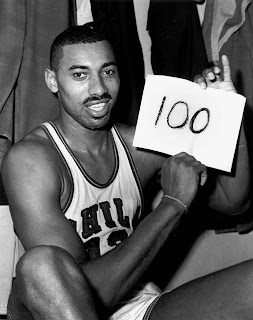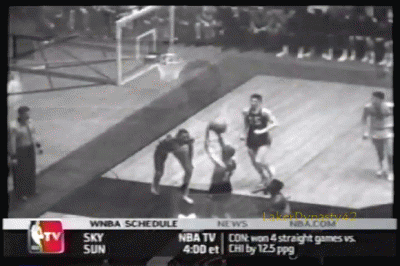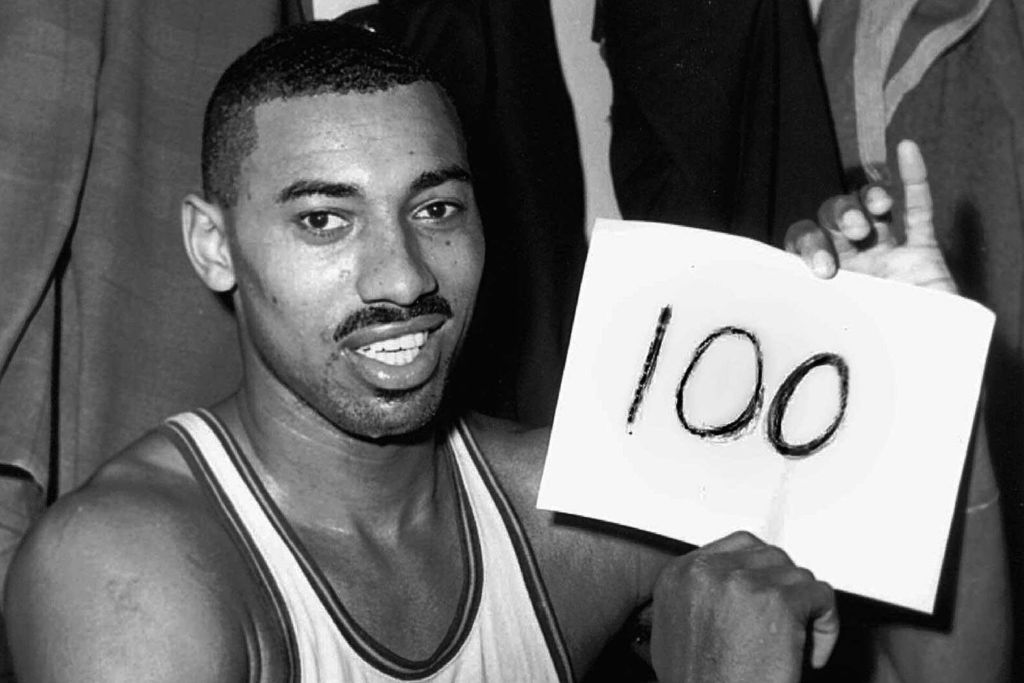Most basketball fans only know the name Wilt Chamberlain because he scored 100 points in a game. They often qualify Wilt's herculean accomplishments by saying he's overrated because he was bigger and taller than anyone else in his era. Oh, what little those fans choose to know. The fact is, there's a hell of a lot more about how spectacular an athlete he was than people know about.
Statistics and video footage of Wilt Chamberlain very strongly suggest that his combination of size (7'1", 275 lbs - he weighed in at 258 as a rookie), strength, athleticism, a vertical leap between 39 and 50 inches (depending on his age and who you talk to), unmatched durability and excellent fundamentals on both ends of the floor would still make him a better and more intimidating player than any big man in today's slower-paced NBA game.
Your Honor, the evidence:
Wilt Chamberlain's dominance started getting nationwide attention when he was a teenager at Overbrook High School in Philadelphia. At Kansas University Chamberlain not only played basketball, he was also a star member of the Track and Field team. He ran the 100-yard dash in 10.9 seconds; the 440 in 48.9 seconds; shot-putted 56 feet; posted a 22' 8' inch broad jump and won the high jump in the Big Eight track and field championships three straight years. By the time he was 21 he had already been featured in Life, Look, Newsweek and Time magazines before he even turned pro.

Wilt left college early and spent a year playing for the Harlem Globetrotters before joining the NBA in 1959 and once he got to the Philadelphia Warriors as a territorial draft choice the records began falling like dominoes. In his very first game, played against the New York Knicks at Madison Square Garden, Wilt set rookie debut records for points (43) and rebounds (28) that still stand. It was a powerful omen.
You know a player is dominant when the powers that be change the rules because of that player. That's what the NCAA and NBA did to Chamberlain. In college, Kansas devised an inbound play from under the basket where the inbounding player would throw the ball over the backboard to a leaping Chamberlain who would jam it home. The NCAA banned that move, as well as some others before he even played one game. The NBA not only did the same, they also widened the free throw lane. In addition, goaltending, which was legal then, was outlawed due to Wilt's uncanny ability to block shots within 10 feet of the basket no matter where the shot originated. Curiously, Wilt was a very poor foul shooter. He had a good shot away from the basket (he had a deadly baseline jumper) but at the line he was one of the worst. He tried every method: two-handed, one handed, even underhanded, to no avail. About the only thing he didn't try was bouncing it in. It's widely speculated that he was working on a way to leap from the foul line and release the ball less than a few feet from the rim before touching the ground. The league, well aware of Wilt's track and field background, nixed that idea, too.
With Chamberlain overwhelming opponents game after game he immediately became a sensation and the NBA's biggest drawing card since the legendary George Mikan. He went on to shatter virtually every scoring and rebounding record (as a rookie, remember) and wrapped up his first year in the NBA with averages of 37.6 points and 27 rebounds a game. Fans and media alike were dumbfounded. Nobody had ever seen this kind of dominance before. Some people feared he would wreck the game. He was criticized and called selfish and a loser, leading him to bitterly lament, "Everybody pulls for David, nobody roots for Goliath."
With Chamberlain overwhelming opponents game after game he immediately became a sensation and the NBA's biggest drawing card since the legendary George Mikan. He went on to shatter virtually every scoring and rebounding record (as a rookie, remember) and wrapped up his first year in the NBA with averages of 37.6 points and 27 rebounds a game. Fans and media alike were dumbfounded. Nobody had ever seen this kind of dominance before. Some people feared he would wreck the game. He was criticized and called selfish and a loser, leading him to bitterly lament, "Everybody pulls for David, nobody roots for Goliath."
 During the 1961-62 season Wilt's scoring average climbed to a surreal 50.4 points a game, highlighted by his unbeatable 100-point effort as well as a 3-overtime game where he poured in 78 points and grabbed 43 rebounds and another game of 73 points and 36 rebounds. [Read the story and the box score of his 100-point game here.]
During the 1961-62 season Wilt's scoring average climbed to a surreal 50.4 points a game, highlighted by his unbeatable 100-point effort as well as a 3-overtime game where he poured in 78 points and grabbed 43 rebounds and another game of 73 points and 36 rebounds. [Read the story and the box score of his 100-point game here.]Here's Chamberlain's game log from that iconic season. Any one of these games would be a career achievement for any player. Wilt Chamberlain was achieving it virtually every game.
In the current era where nobody plays all 48 minutes of a game, Chamberlain averaged a seemingly impossible 48.5 minutes a game in 1961-62. He played every minute of a game (including overtime minutes) 79 times that season, including 47 in a row.
In his 7th season Wilt scored his 20,000th point in his 499th career game, which by far remains (and likely will always remain) the record for the fastest to achieve that milestone.
In his 7th season Wilt scored his 20,000th point in his 499th career game, which by far remains (and likely will always remain) the record for the fastest to achieve that milestone.
Wilt never fouled out of a game, which spanned 1,205 games including 160 playoff contests.
He's the only player to record a 40/40 (at least 40 points and 40 rebounds in one game) and he did it five times.
Six players have scored 70 or more points in a game. Wilt did it six times.
Michael Jordan scored 50 or more points 31 times in his career. Wilt Chamberlain did it 45 times in one season and 118 times in his career.
The second best scoring average by a player not named Chamberlain was Elgin Baylor's 38.3 in 1961-62, the same year as Wilt's 50.4. That makes Wilt's number 31.6 percent higher than Baylor. Now let's put that into perspective:
• The highest batting average for a season in Major League Baseball over the past 70 years is Tony Gwynn's .394 in 1994. To exceed Gwynn by 31.6 percent, a batter would have to hit .518.
• The all-time single season rushing record in the NFL is 2,105 yards by Eric Dickerson in 1984. To exceed Dickerson by 31.6 percent a runner would have to gain 2,770 yards.
• The NHL single-season record for goals is 92 by Wayne Gretzky in 1981-82. To exceed Gretzky by Chamberlain's pace, a player would have to score 121 goals.
There are those who claim that all Chamberlain could do was score. However, much to their ignorance, Wilt had 78 career triple-doubles, more than Larry Bird (59), Michael Jordan (31) and Kobe Bryant (21). Wilt had 31 of them in one season.
In 1960 Wilt grabbed an astonishing 55 rebounds in one game, against Bill Russell, no less. He's said to have been more proud of this record than his 100-point game because it was harder to do.
In 1966-67 Wilt won his first championship (dethroning the 8-time defending champion Boston Celtics in the playoffs along the way) when he averaged 24.1 points, 24.2 rebounds and 7.8 assists a game and led the Philadelphia 76ers to a 68-13 record and the NBA title. Here's Wilt's game log from that historic season.In 1960 Wilt grabbed an astonishing 55 rebounds in one game, against Bill Russell, no less. He's said to have been more proud of this record than his 100-point game because it was harder to do.
Chamberlain followed up that season in 1967-68 by becoming the only center to lead the league in total assists in a season with 702. His numbers were 24.3/23.8/8.6. The peak of that season ocurred on February 2, 1968 when he became the first player in NBA history to get a double triple-double (at least 20 points, 20 rebounds and 20 assists in one game). It took 51 years before Russel Westbrook became the second one. Here's the box score of Wilt's game.
Occasionally, somebody would count hifferent stats during a given game. In 1968 Chamberlain produced an unofficial quintuple-double with 53 points, 32 rebounds, 14 assists, 24 blocks and 11 steals.
Wilt had 40 or more rebounds in a game 14 times. Bill Russell did it 11 times. The only others members of the 40-rebound club are NBA Hall Of Famers Nate Thurmond and Jerry Lucas who each did it once.
Off the court, Wilt could palm a bowling ball, bench press 465 lbs, clean-and-jerk 375 lbs, deadlift 625 lbs among other feats of strength, and life after basketball saw him become a Hall Of Fame volleyball player.
Some quotes about Wilt Chamberlain:
NBA great Johnny Kerr -- "Once Wilt got upset with me and dunked the ball so hard it went through the rim with such force that it broke my toe as it hit the floor."
Hall Of Fame coach Alex Hannum -- "When I coached the San Francisco Warriors, I thought Al Attles was the fastest guy on our team--by far. We used to gamble a lot--which player could jump the highest and run the fastest. So I set up a series of races, baseline to baseline. In the finals, it was Wilt and Al Attles and Wilt just blew past him. I'm convinced that Wilt Chamberlain is one of the greatest all-around athletes the world has ever seen."
Some quotes about Wilt Chamberlain:
NBA great Johnny Kerr -- "Once Wilt got upset with me and dunked the ball so hard it went through the rim with such force that it broke my toe as it hit the floor."
Hall Of Fame coach Alex Hannum -- "When I coached the San Francisco Warriors, I thought Al Attles was the fastest guy on our team--by far. We used to gamble a lot--which player could jump the highest and run the fastest. So I set up a series of races, baseline to baseline. In the finals, it was Wilt and Al Attles and Wilt just blew past him. I'm convinced that Wilt Chamberlain is one of the greatest all-around athletes the world has ever seen."
Al Attles -- "I'd see what the other players were doing to Wilt and what the officials were allowing, and I'd get more upset than if it were happening to me. It wasn't that Wilt couldn't defend himself...If he ever got really hot, he'd kill people, so he let things pass."
New York Knick Darrell Imhoff, the starting opposing center the night Wilt scored 100 points -- "I can't have a nightmare tonight. I've just lived through one."
New York Knick Darrell Imhoff, the starting opposing center the night Wilt scored 100 points -- "I can't have a nightmare tonight. I've just lived through one."
Former teammate Tom Meschery -- "A lot of people are walking around today only because Wilt never lost his temper."
Hall Of Fame Boston Celtic K.C. Jones -- "He stopped me dead in my tracks with his arm, hugged me and lifted me off the floor with my feet dangling. It scared the hell out of me. When I went to the free-throw line, my legs were still shaking. Wilt was the strongest guy and best athlete ever to play the game."
Rugged power forward Paul Silas -- "One time, when I was with Boston and he was with the Lakers, Happy Hairston and I were about to get in a scrape. All of a sudden, I felt an enormous vise around me. I was 6-7, 235 and Wilt had picked me up and turned me around. He said, 'We're not going to have that stuff.' I said,'Yes sir.'"
Hall Of Fame center Bob Lanier who was 6'11", 260 lb. -- "When he picked me up here and put me down there, I thought he was the baddest."
Hall Of Fame power forward/center Elvin Hayes -- "He was such an awesome physical specimen. To go up under Wilt Chamberlain, to be down there and look up at him when he's towering up over you waiting to dunk, was a terrifying picture. Everyone was scared when he got that "Don't try to stop this" look.
Hall Of Famer Walt "Clyde" Frazier -- "His legacy is comical. When you read about his records, it makes you laugh. He has records that are just remarkable. I don't care if he was 10 feet tall, the things that he did."
Chamberlain showed some interest in football which attracted the attention of legendary coach Hank Stram, who invited Wilt to a workout. Here's what happened:
Chamberlain showed some interest in football which attracted the attention of legendary coach Hank Stram, who invited Wilt to a workout. Here's what happened:
And some video highlights.
It's a credit to Wilt Chamberlain's awesome athletic ability that he kept getting comeback offers for 18 years after his retirement. "Bulls, Cavaliers, Nets, Knicks twice, Sixers twice, Mavericks, Suns, Clippers - those are all the teams that tried to get me in the last decade," Chamberlain said in 1991. "It's great for the ego to think at age 50, 52, 53 that guys think I could still go out and play. And personally, I think I could do it. But I have no desire. The time I had was enough."
It's a credit to Wilt Chamberlain's awesome athletic ability that he kept getting comeback offers for 18 years after his retirement. "Bulls, Cavaliers, Nets, Knicks twice, Sixers twice, Mavericks, Suns, Clippers - those are all the teams that tried to get me in the last decade," Chamberlain said in 1991. "It's great for the ego to think at age 50, 52, 53 that guys think I could still go out and play. And personally, I think I could do it. But I have no desire. The time I had was enough."


















